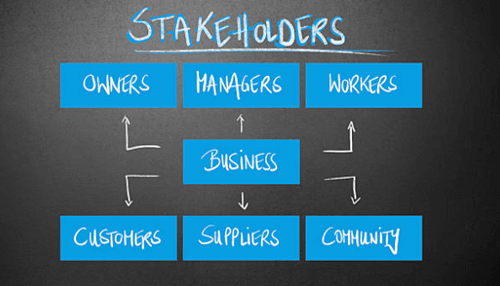What is a Stakeholder?
A stakeholder is a party, group, or any individual having an interest in an organization and its outcomes. Stakeholders include customers, employees, suppliers, shareholders, governments, and communities. Every organization or business has stakeholders. There are different types of stakeholders having a stake or interest in the business. They work for the business or organization’s success.
Types of Stakeholders
1. Owners:
The business owners are the first set of stakeholders. They contribute equity or capital and can stay in the business running system. A few may be a partnership case, while mostly the large numbers are a joint-stock company.
2. Employees:
The next set of stakeholders are employees in any business. These employees may perform managerial or supervisory functions. They can be of any cadre and draw remuneration to make the business or company function. Nowadays, such employees have a share in the company. It enhances their stake. Thus, in large organizations, such employees are spread over numerous functions in the business.
3. Customers:
Customers are the main force for any business to keep going. It is customers who get their services and products from businesses and are interested in the progress of a business. Thus, customers are an important type of stakeholder group. They make conscious efforts to meet the expectations and needs.
4. Community:
The community that has business operations is a set of stakeholders. There are sound businesses and good organizations that are an asset to a community. The organizations contribute to welfare programs, such as maintaining parks, gardens, and fountains. They also take up activities for the goodness of the community and assume significance in the business organization.
5. Communication Needs of Any Business Organization:
There are agencies and people beyond the stakeholders. It is a must for a business or an organization to communicate with people for various reasons. It is an ongoing routine. Business communication covers several types, methods, strategies, and channels, addressing communication needs.
6. Government:
Each business falls in the realm of government agencies. It may be central or national, state or provincial, or local. Every business quite often complies with various rules and regulations of the government. Communication between the government and business organizations is one of the types of stakeholders.
7. Trade Organizations:
Each business has a membership or affiliation with a trade organization. It may be geographical or functional. They work with larger interests in mind. Trade organizations are associated with most businesses and organizations forming an integral part.
8. Competitors:
Various players operate, and, on many occasions, they communicate with each other. Different players, using a competitive nature, respond to their customers arriving at some understanding. There may be a clash of interests to sort out. Yet, businesses have to communicate with other operators and competitors in the market.
9. Press and Media:
Businesses need to interact or communicate with the press, television, and media. It is essential for announcements, clarification, advertisement, or image building. For a larger organization, media contact and press relations are essential functions requiring attention.
10. Consumer Fora:
This section deals with varied consumer organizations, consumer lobbies, and consumer courts. There is a host of agencies interacting, and it could include employment agencies, judicial organs, financial institutions, supervising agencies, international bodies, and charitable institutions.
Communication plays a crucial role in all types of stakeholders. The effectiveness of a business relies on its ability to communicate with all the sections it interacts with. Effective communication is a must to have operative performance. Thus, organizations perform numerous activities through various individuals and departments. Communication facilitates the integration of activities.




